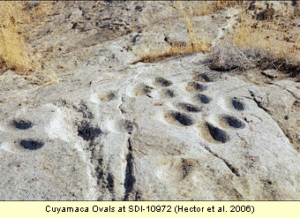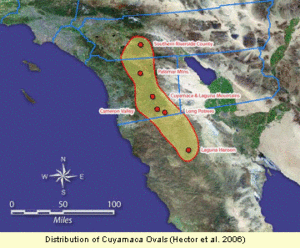Cuyamaca Oval Basin Metates
Within the general class of bedrock milling features, a distinctive type of basin, termed the Cuyamaca Oval, has been discussed by Susan M. Hector, Daniel G. Foster, Linda C. Pollack, and Gerrit L. Fenenga (2006, 2009). These investigators have suggested that the features may have been limited in their chronological and geographical ranges and in their functions.
 D. L. True is credited with first distinguishing the features in his study of the archaeology of Cuyamaca Rancho State Park: “Bedrock milling stones range from polished slicks to oval depressions up to 2 inches deep. It is obvious that this is not just a range of depth due to the length of time a grinding area was in use. The oval depressions are consistently the same shape and are not the end product of long use of a previous slick. It is uncertain, however, whether these forms represent differences in time or cultural affiliation, or are ecological in nature” (True 1970:17).
D. L. True is credited with first distinguishing the features in his study of the archaeology of Cuyamaca Rancho State Park: “Bedrock milling stones range from polished slicks to oval depressions up to 2 inches deep. It is obvious that this is not just a range of depth due to the length of time a grinding area was in use. The oval depressions are consistently the same shape and are not the end product of long use of a previous slick. It is uncertain, however, whether these forms represent differences in time or cultural affiliation, or are ecological in nature” (True 1970:17).
Hector and her colleagues acknowledged that they were not yet able to formulate a satisfactory objective definition of the Cuyamaca Oval, but they suggested several characteristic attributes of the type, including:
- uniform shape
- elliplical
- some are very narrow, and some are narrow at one end
- depths ranging from 2.2 to 3.9 centimeters
- steep sides with slopes of 40-45 degrees at the midpoint
- arrangement of two or more features in a curved arc
- “deer hoof” pattern of closely spaced basins
- few if any mortars found at sites with ovals
 The core area delineated for Cuyamaca Ovals is the Peninsular Range province of San Diego County, extending into southwestern Riverside County and into northern Baja California as far south as Laguna Hanson. However, Hector and her colleagues noted the presence of similar if not identical features with similar associations in other parts of California, including sites in El Dorado, Sierra, Shasta, and Lake counties.
The core area delineated for Cuyamaca Ovals is the Peninsular Range province of San Diego County, extending into southwestern Riverside County and into northern Baja California as far south as Laguna Hanson. However, Hector and her colleagues noted the presence of similar if not identical features with similar associations in other parts of California, including sites in El Dorado, Sierra, Shasta, and Lake counties.
Both oval basins and mortars are present at some sites. More commonly they seem to occur separately, according to the investigators.
Studies of site distributions at Cuyamaca (Foster 1980, 1981; Parkman 1981) and on Mount Laguna (Graham 1981) indicated that the basins are associated with the edges of meadows and were perhaps used specifically to process meadow resources, such as grass and annual seeds.
Alternative chronological and functional hypotheses have been proposed to explain Cuyamaca Ovals:
— Considered as chronologically diagnostic features, Cuyamaca Ovals may date from the Archaic period, prior to the Late Prehistoric period of the last 1,000 years or so. They may testify to an Archaic focus on small seeds and nuts, in contrast to a Late Prehistoric focus on acorns. The weathering and fracturing observed on some basins have been suggested as indications of their substantial age, in contrast to the better-preserved and presumably more recent milling features seen at bedrock mortar sites.
— Cuyamaca Ovals may have been used to process specific plant resources at specialized locations. They may have been contemporaneous with but situated apart from Late Prehistoric villages and camps.
PROSPECTS
Future archaeological studies may make use of archived information as well as new field studies to delineate more exactly the geographical range of Cuyamaca Ovals, if an objective, practical, and insightful definition of the type can be established. Such studies may be able to evaluate the specific topographic and biotic associations of the features, and their associations with functionally distinctive site types, chronologically diagnostic artifacts, and other types of bedrock milling features. Evaluation of individual outcrops containing both basins and mortars may be able to determine whether one feature type or the other consistently preempted the most suitable positions, which would suggest priority in the use of that type. Studies of basins that occur in dense concentrations on some outcrops may be able to shed light on the question of whether multiple features were used simultaneously by a single individual for identical or complementary functions, whether features became “exhausted” after a period of use, or whether the use of individual features was restricted to their “owners.” Replicative studies may be able to determine the amount of work required to create Cuyamaca Ovals, the types of milling uses to which they were particularly suited, the probable manner in which milling was done within them, and whether they were subject to exhaustion.